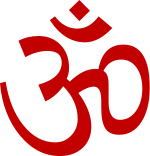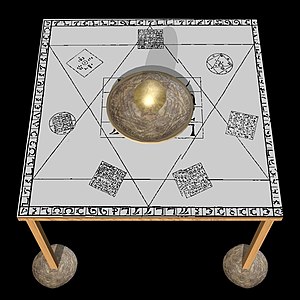- Mahavatar Babaji
- Born: November 30, 203 AD
Mahavatar Babaji (IAST: Mahāvatār Bābājī) is the name given to an Indian saint by Shyāmacharan Lahirī and several of his disciples[1] who met Mahavatar Babaji between 1861 and 1935. Some of these meetings were described by Paramahansa Yogananda in his book Autobiography of a Yogi, including a first hand telling of Yogananda's own meeting with Mahavatar Babaji.[2] Another first hand account was given by Yukteswar Giri in his book The Holy Science.[3] All of these accounts, along with additional meetings with Mahavatar Babaji, are described in various biographies[4][5][6] of those mentioned by Yogananda.
Mahavatar Babaji's given name is unknown, so those who met him during that period all called him by the title first given to him by Lahirī.[2][6] "Mahavatar" means "great avatar", and "Babaji" simply means "revered father". Some of the encounters included two or more witnesses—discussions between those who met Mahavatar Babaji indicate that they all met the same person.
Childhood[edit]
There are very few accounts of Babaji's childhood, one source of information is the book Babaji and the 18 Siddha Kriya Yoga tradition by Marshall Govindan.[7] According to Govindan, Babaji was named Nagarajan (king of serpents) by his parents. V.T. Neelakantan and S.A.A. Ramaiah founded on 17 October 1952, (they claim – at the request of Babaji) a new organisation, "Kriya Babaji Sangah," dedicated to the teaching of Babaji's Kriya Yoga. They claim that in 1953 Mahavatar Babaji told them that he had been born on 30 November 203 CE in a small coastal village now known as Parangipettai, in Tamil Nadu, India.[8] Babaji's Kriya Yoga Order of Acharyas Trust (Kriya Babaji Sangah) and their branch organisations claim his place and date of birth.[8] He was a disciple of Bogar and his birth name is Nagarajan.[7][8]
In the writings of Paramahansa Yogananda in his Autobiography of a Yogi, many references were made to Mahavatar Babaji including from Lahirī and Yukteshwar.[2] In his book The Second Coming of Christ, Yogananda states that Jesus Christ went to India and conferred with Mahavatar Babaji. This would make Babaji at least 2000 years old.[9] According to Govindan's book, Babaji Nagaraj's father was the priest of the village's temple. Babaji revealed only those details which he believed to be formative as well as potentially instructive to his disciples. Govindan mentioned one incident like this: "One time Nagaraj's mother had got one rare jackfruit for a family feast and put it aside. Babaji was only 4 years old at that time. He found the jackfruit when his mother was not around and ate it all. When his mother came to know about it, she flew in blind rage and stuffed a cloth inside Babaji's mouth, nearly suffocating him, but he survived. Later on he thanked God for showing him that she was to be loved without attachment or illusion. His Love for his mother became unconditional and detached."[7]
When Nagaraj was about 5 years old, someone kidnapped him and sold him as a slave at Calcutta (Now Kolkata). His new owner however was a kind man and he freed Nagaraj shortly thereafter. Nagaraj then joined a small group of wandering sannyāsin due to their radiant faces and love for God. During the next few years, he wandered from place to place, studying holy scriptures like the Vedas, Upanishad, Mahabharata,Ramayana, Bhagavad Gita
Quest for self realisation[edit]
According to Marshall Govindan's book, at the age of eleven, he made a difficult journey by foot and boat with a group of ascetics to Kataragama, Sri Lanka. Nagaraj met Siddha Bhogarnathar and became his disciple. Nagaraj performed intensive yogic sadhana for a long time with him. Bhogarnather inspired Nagaraj to seek his initiation into Kriya Kundalini Pranayam from Siddha Agastya. Babaji became a disciple of Siddha Agastya. Nagaraj was initiated into the secrets of Kriya Kundalini Pranayama or "Vasi Yogam". Babaji made a long pilgrimage to Badrinath and spent eighteen months practising yogic kriya taught to him by Siddha Agastya and Bhogarnathar. Babaji attained self-realization shortly thereafter.[7]
They (who?) also claim that these revelations were made by Babaji himself to S.A.A. Ramaiah, a young graduate student in geology at the University of Madras and V.T. Neelakantan, a famous journalist, and close student of Annie Besant, President of the Theosophical Society and mentor of Krishnamurti. Babaji was said to have appeared to each of them independently and then brought them together to work for his Mission in 1942
Reports of meetings, 1861–1966[edit]
Shyāmacharan Lahirī[edit]
Main article: Lahiri Mahasaya
The first reported encounter with Mahavatar Babaji was in 1861, when Shyāmacharan Lahirī (called "Mahāsaya" by disciples, devotees, and admirers) was posted to Ranikhet in his work as an accountant for the British government. One day while walking in the hills of Dunagiri above Ranikhet, he heard a voice calling his name. Following the voice up the mountain, he met a "tall, divinely radiant sadhu."[6] He was amazed to find that the sadhu knew his name.[2][6] This sadhu was Mahavatar Babaji.
Mahavatar Babaji told Lahirī that he was his guru from the past, then initiated him into Kriya Yoga and instructed Lahiri to initiate others. Lahiri wanted to remain with Mahavatar Babaji, who told him instead that he must return to the world to teach Kriya Yoga and that "Kriya Yoga sadhana would spread through the people of the world through his (Lahiri's) presence in the world."[6]
Lahirī reported that Mahavatar Babaji did not give his name or background, so Lahiri gave him the title "Mahavatar Babaji." Many sadhus in India are called Babaji, and sometimes even "Babaji Maharaj", which has caused confusion between Mahavatar Babaji and other sadhus with similar names.[6]
Lahirī had many meetings with Mahavatar Babaji, recounted in several books, including Paramhansa Yogananda's Autobiography of a Yogi,[2] Yogiraj Shyama Charan Lahiri Mahasaya (Lahiri's biography),[6] andPurana Purusha: Yogiraj Sri Shama Churn Lahiri,[11] among others.
The references of Sri Lahiri mahasaya in Sampoorna sri pada vallabha charitam, as the guru of Sri Shirdi sai baba and initiating him to kriya yoga.
Disciples of Shyāmacharan Lahirī[edit]
Several disciples of Shyāmacharan Lahirī also said that they had met Babaji. Through discussion with each other, and the fact that some of these encounters included two or more witnesses, they confirmed that the person they saw was the same sadhu that Lahirī called Mahavatar Babaji.[2][6][12]
In 1894, at the Kumbha Mela in Allahabad, Yukteswar Giri, a disciple of Lahirī, met Mahavatar Babaji. He was surprised by the striking resemblance between Lahirī and Mahavatar Babaji.[2][5] Others who met Babaji also commented on the resemblance.[6] It was at this meeting that Mahavatar Babaji instructed Sri Yukteswar to write the book that was to become Kaivalya Darshanam, or The Holy Science.[3] Yukteswar had two more meetings with Mahavatar Babaji, including one in the presence of Lahiri Mahasaya.[2][5][6]
Pranabananda Giri, another disciple of Lahirī, also met Mahavatar Babaji in the presence of Lahirī, at Lahirī's home. Pranavananda asked Mahavatar Babaji his age. Mahavatar Babaji responded that he was about 500 years old at that time.[4]
Keshabananda, a disciple of Lahirī, tells of meeting Mahavatar Babaji in the mountains near Badrinath around 1935, after he became lost wandering in the mountains.[2] At that meeting, Pranabananda reported that Babaji gave him a message for Paramahansa Yogananda, that "I won't see him this time, as he is eagerly hoping; but I shall see him on some other occasion."[2] In his book Autobiography of a Yogi, Paramahansa Yogananda wrote that Mahavatar Babaji visited him before his journey to America and addressed him saying, "You are the one I have chosen to spread the message of Kriya Yoga in the West."[2]
Other disciples of Lahirī who reported meetings with Mahavatar Babaji include Kebalananda Giri[12] and Ram Gopal Muzumdar, who recounted meeting Mahavatar Babaji and his sister, whom he called Mataji.[2][6] In addition, a disciple of Trailanga Swami, Shankari Mata (also called Shankari Mai Jiew) met Mahavatar Babaji while visiting Lahiri Mahasaya
Traditional legends[edit]
Legendary powers and age have been attributed to Mahavatar Babaji by the disciples of Lahirī. These stories have led many to believe that Mahavatar Babaji is a legendary person, rather than a real sadhu that was seen by numerous witnesses from 1861 to 1935.
Paramahansa Yogananda, in his Autobiography, described Mahavatar Babaji's role on earth:
In addition, Babaji is reputed to be ageless, according to some accounts, and about 500 years old around the late 1800s, according to Pranabananda.[4] Yogananda reports that, according to the disciples of Lahirī, nobody knows Babaji's age, family, place of birth, true name, or other details "dear to the annalist's heart."[2]
According to Yogananda's autobiography, he has a sister called Mataji (meaning "Holy Mother") who also has lived throughout the centuries. Her level of spiritual attainment is comparable to her brother's, and she lives in a state of spiritual ecstasy in an underground cave. Although only three pages in the book are dedicated to her, she is described by Ram Gopal as "young and surpassingly lovely" as well as a "glorious woman."[2]
Yogananda frequently prayed out loud to "Babaji-Krishna."
Modern claims and popular references[edit]
Mahavatar Babaji was one of the many people featured on the cover of The Beatles' 1967 album Sgt. Pepper's Lonely Hearts Club Band.[14]
In Book 3 of Conversations with God (1998), by Neale Donald Walsch, it is suggested that Babaji may at one time have resurrected himself from the dead.[15]
In the Book Ultimate Journey (1994), by Robert Monroe Monroe visits a person through his astral projection (although no name is mentioned) who turns out to have lived one single life for 1800 years, which would suggest that he was born around 203 CE.
The 2002 Tamil film Baba written by Rajinikanth was based on Babaji. Swami Maheshwarananda writes in his book The hidden power in humans, that the Guru of the legendary Babaji is Sri Alakh Puriji.[16]
In his autobiography Apprenticed to a Himalayan master: a yogi's autobiography (2010), Sri M (Mumtaz Ali) narrates his meeting with Babaji near Neelkant hill.[17] In his book, Sri M gave description of Babaji as golden complexioned, bare-bodied, except for a shinning white loin cloth that barely reached the knees, and flowing brown hair that fell to his shoulders. He mentioned that a lovely scent emanated from Babaji and he looked divine.
The rock band Supertramp composed a song called "Babaji" in reference to Mahavatar Babaji.



